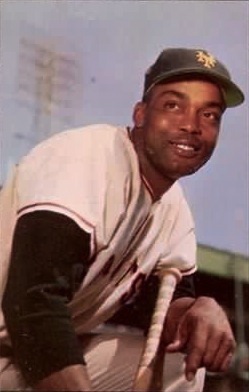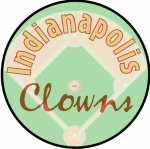Related Research Articles
The Negro leagues were United States professional baseball leagues comprising teams of African Americans. The term may be used broadly to include professional black teams outside the leagues and it may be used narrowly for the seven relatively successful leagues beginning in 1920 that are sometimes termed "Negro Major Leagues".

Ernest Banks, nicknamed "Mr. Cub" and "Mr. Sunshine", was an American professional baseball player who starred in Major League Baseball (MLB) as a shortstop and first baseman for the Chicago Cubs between 1953 and 1971. He was inducted into the National Baseball Hall of Fame in 1977, and was named to the Major League Baseball All-Century Team in 1999.

Monford Merrill "Monte" Irvin was an American left fielder and right fielder in the Negro leagues and Major League Baseball (MLB) who played with the Newark Eagles, New York Giants (1949–1955) and Chicago Cubs (1956). He grew up in New Jersey and was a standout football player at Lincoln University. Irvin left Lincoln to spend several seasons in Negro league baseball. His career was interrupted by military service from 1943 to 1945.

Henry Curtis Thompson was an American player in the Negro leagues and Major League Baseball who played primarily as a third baseman. A left-handed batter, he played with the Dallas Green Monarchs (1941), Kansas City Monarchs, St. Louis Browns (1947) and New York Giants (1949–56).
The Negro American League was one of the several Negro leagues created during the time organized American baseball was segregated. The league was established in 1937, and disbanded after its 1962 season.

The Kansas City Monarchs were the longest-running franchise in the history of baseball's Negro leagues. Operating in Kansas City, Missouri, and owned by J. L. Wilkinson, they were charter members of the Negro National League from 1920 to 1930. J. L. Wilkinson was the first Caucasian owner at the time of the establishment of the team. In 1930, the Monarchs became the first professional baseball team to use a portable lighting system which was transported from game to game in trucks to play games at night, five years before any major league team did. The Monarchs won ten league championships before integration, and triumphed in the first Negro League World Series in 1924. The Monarchs had only one season in which they did not have a winning record. The team produced more major league players than any other Negro league franchise. It was disbanded in 1965.

Willard Jessie Brown, nicknamed "Home Run" Brown, was an American baseball player who played outfielder in the Negro leagues for the Kansas City Monarchs and in Major League Baseball (MLB) for the St. Louis Browns. For the Monarchs, he led the Negro American League in hits for eight seasons and runs batted in (RBI) seven times during his career. His eight times leading a league in hits is tied with Ty Cobb for most in baseball history while his seven times leading in RBI for a league is tied for second-most in baseball history with Josh Gibson; Gibson and Brown also finished in the top two in batting average in five seasons each, most in Negro league history. He is a member of the National Baseball Hall of Fame and Museum.

Kansas City Municipal Stadium was an American baseball and football stadium in the central United States, located in Kansas City, Missouri. It was located at the corner of Brooklyn Avenue and E. 22nd Street.

The East–West All-Star Game was an annual all-star game for Negro league baseball players. The game was the brainchild of Gus Greenlee, owner of the Pittsburgh Crawfords. In 1933 he decided to emulate the Major League Baseball All-Star Game, using Negro league players. Newspaper balloting was set up to allow the fans to choose the starting lineups for that first game, a tradition that continued through the series' end in 1962. Unlike the white All-Star game which is played near the middle of the season, the Negro All-Star game was held toward the end of the season.

Sunset High School is a public secondary school located in the North Oak Cliff area of Dallas, Texas, United States. The school enrolls students in grades 9-12 and is a part of the Dallas Independent School District (DISD). The school serves a portion of the Dallas and Cockrell Hill catchments. In 2015, the school was rated "Met Standard" by the Texas Education Agency.

Andrew Lewis Cooper, nicknamed "Lefty", was an American left-handed pitcher in baseball's Negro leagues. He was elected to the Baseball Hall of Fame in 2006. An alumnus of Paul Quinn College, Cooper played nine seasons for the Detroit Stars and ten seasons for the Kansas City Monarchs, and briefly played for the Chicago American Giants. The Texan was 6 feet 2 inches (188 cm) tall and weighed 220 pounds.

The Indianapolis Clowns were a professional baseball team in the Negro American League. Tracing their origins back to the 1930s, the Clowns were the last of the Negro league teams to disband, continuing to play exhibition games into the 1980s. They began play as the independent Ethiopian Clowns, joined the Negro American League as the Cincinnati Clowns and, after a couple of years, relocated to Indianapolis. Hank Aaron was a Clown for a short period, and the Clowns were also one of the first professional baseball teams to hire a female player.

Samuel Crawford was an American pitcher and manager in baseball's Negro leagues.

The Dallas Black Giants were professional and semi-professional baseball teams based in Dallas, Texas which played in the Negro leagues. They were active on and off from 1908 to 1949. Among the leagues that the Black Giants played for were the Texas Colored League (1916), the Negro Texas League, the Texas-Oklahoma-Louisiana League (1929), the Colored Texas League (1931), and - after two years of inactivity in 1936 & 1937—the Texas-Oklahoma-Louisiana League (1938). They played their home games at the original Gardner Park prior to it burning down, Riverside Park and Steer Stadium. In the 1920s and 1930s, live jazz was featured during the games. Beauty contests became a feature in games during the 1930s. One of the best known players on the Black Giants was shortstop Ernie Banks who would go on to become a star in Major League Baseball for the Chicago Cubs. An infamous player was left-handed pitching star Dave Brown who got into involved in a highway robbery. Reportedly a fugitive, Chicago American Giants' Rube Foster paid $20,000 for Brown's parole and he became a member of Foster's Chicago American Giants.
The Memphis Red Sox were an American Negro league baseball team that was active from 1920 to 1959. Originally named the Barber College Baseball Club, the team was initially owned and operated by Arthur P. Martin, a local Memphis barber. In the late 1920s the Martin brothers, all three Memphis doctors and businessmen, purchased the Red Sox. J. B. Martin, W. S. Martin, and B. B. Martin, would retain control of the club till its dissolution in 1959. The Red Sox played as members, at various times, of the Negro Southern League, Negro National League, and Negro American League. The team was never a titan of the Negro leagues like wealthier teams in northern cities of the United States, but sound management lead to a continuous thirty-nine years of operation, a span that was exceeded by very few other teams. Following integration the team had five players that would eventually make the rosters of Major League Baseball teams and two players that were inducted into the Baseball Hall of Fame.

John Ford Smith was an American Negro league pitcher in the 1930s and 1940s.

Henry “Hank” Baylis was an American Negro league infielder in the 1940s and 1950s.

L. D. Livingston, nicknamed "Larry" and "Goo Goo", was an American Negro league outfielder between 1928 and 1932.
References
- ↑ "Wonders Beat Monarchs; Resume Tourney Today"." Dallas Morning News, 13 September 1940, p. 4.
- ↑ "Dallas Negro Team Winner." Dallas Morning News, 18 August 1947, p. 10.
- ↑ Heaphy, Leslie A. Black Baseball and Chicago: Essays on the Players, Teams and Games. Jefferson, NC: McFarland, 2006: p. 185.
- ↑ Hamm, Theodore. Hank Thompson's Blues. Seattle, WA: Nobody Rocks Press, 2009: p. 21, 79.
- ↑ "Monarchs Win." Dallas Morning News, 20 April 1953, p. 17.
- ↑ "North Texas League Opens Season Chase." Dallas Morning News, 5 April 1954, p. 16; "Negro Ball Loop Opens 1955 Play." Dallas Morning News, 4 April 1955, p. 18.